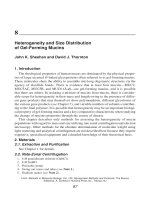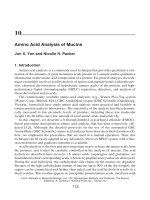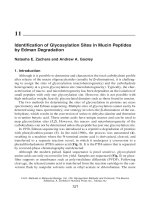Glycoprotein methods protocols - biotechnology 048-9-249-259.pdf
Bạn đang xem bản rút gọn của tài liệu. Xem và tải ngay bản đầy đủ của tài liệu tại đây (101.44 KB, 11 trang )
Intracellular Processing of Mucin Precursors 249
249
21
Mucin Precursors
Identification and Analysis of Their Intracellular Processing
Alexandra W. C. Einerhand, B. Jan-Willem Van Klinken,
Hans A. Büller, and Jan Dekker
1. Introduction
MUC-type mucins are generally very large glycoproteins. They are encoded by
very large mRNAs, and possess polypeptides between 200 and more than 900 kDa (1).
The only notable exception is MUC7, which is considerably smaller, i.e. the polypep-
tide is only 39 kDa (1). Without exception however, mucins are very heavily O-
glycosylated: Up to 50-80% of their molecular mass is due to O-glycosylation (1,2).
Moreover, potential N-glycosylation sites are found in virtually all mucin sequences,
and in several MUCs N-glycosylation is actually demonstrated (1,2). Human MUC2
for instance contains 30 potential N-glycosylation sites, and if these are all used, the
N-glycans together would constitute a molecular mass of about 60 kDa. It is only the
very large size of the mature mucins, that makes the amount of N-glycosylation seem
insignificant (3). Generally, the sizes of the mature mucins are difficult to estimate;
The approximations run from 1 to 20 MDa for single mucin molecules, which ham-
pers many forms of biochemical analysis (3). Also, the extensive glycosylation of
mucins results in an intrinsically very heterogeneous population of mature mucins.
The detection of mucin precursors forms an attractive alternative to assess the
expression of specific mucins and to quantify mucin synthesis. Each precursor of the
MUC-type mucins can be identified by immunoprecipitation using specific anti-mucin
polypeptide antibodies (see Chapter 20). Very importantly, each of these precursors
can be identified on reducing SDS-PAGE by its distinct molecular mass (3–5). Thus,
immunoprecipitation in combination with sodium dodecyl sulfate-polyacrylamide gel
electrophoresis (SDS-PAGE) can be used to detect expression of individual MUC-
type mucins with high specificity in homogenates of tissue or cell lines. The mucin
precursor bands, recognizable on SDS-PAGE, can be quantified as sensitive measures
of mucin biosynthesis (see Chapter 6).
From:
Methods in Molecular Biology, Vol. 125: Glycoprotein Methods and Protocols: The Mucins
Edited by: A. Corfield © Humana Press Inc., Totowa, NJ
250 Einerhand et al.
Biochemically and cell biologically, MUC-type mucin precursors can be recog-
nized by a number of characteristics, which will help in their identification (2,3). Like
any glycoprotein, the MUC polypeptide is synthesized at the rough endoplasmic reticu-
lum (RER) and cotranslationally N-glycosylated. The product of this initial stage of
biosynthesis will be referred to as the mucin precursor. Then, the precursors will
oligomerize through formation of disulfide bonds, and be transported to the Golgi
apparatus, where they will be fully O-glycosylated and sulfated, as many of the O-
glycans of mucins contain terminal sulfate (see Chapter 17). Mucins that have com-
pleted synthesis are referred to as mature mucins.
In this Chapter, we focus on the identification of each of the known MUC-type
mucin precursors by immunoprecipitation using antipeptide antibodies. Moreover, a
number of biochemical and cell biological assays will be described which establish
the presence in the RER of each alleged MUC-type mucin precursor. These assays are
based on the following characteristics of the mucin precursors (1–3): (1) The pre-
cursors contain only high mannose N-glycans, (2) Most precursors form, over time,
disulfide-linked dimers within the RER, (3) O-glycosylation of the precursors, and
conversion of the N-linked glycans to complex N-glycans, occurs only after their trans-
port to the Golgi apparatus, and (4) A clear precursor/product relationship exists, as a
result of the conversion over time of the precursors into their cognate mature mucins.
The described methods will help researchers in the field to recognize and quantify the
precursors of the known MUC-type mucins, and we will provide appropriate control
experiments to verify the specificity of each of these procedures. Moreover, these
methods will help to allocate previously unidentified mucin precursors.
2. Materials
1. Source of mucin-producing cells, such as biopsies, tissue explants, or cell lines, which are
cultured as described in Chapter 18.
2. Radioactively labeled essential amino acids (Amersham, Little Chalfont, Bucking-
hamshire, UK), described in detail in Chapter 19:
a.
L
-(
35
S)methionine/(
35
S)cysteine (Pro-Mix™).
b.
L
-(
3
H)threonine.
3. Media (Gibco/BRL, Gaitersburg MD) for metabolic pulse-labeling and chase incubations,
as described in detail in Chapter 19.
4. Homogenization buffer for immunoprecipitation, as described in Chapter 20.
5. Glass/Teflon tissue homogenizer, 5 mL model (Potter/Elvehjem homogenizer).
6. Anti-mucin antisera directed against the mucin-polypeptide of interest (see Chapter 20,
Table 1).
7. Protein A-containing carrier to precipitate immunocomplexes, as described in Chapter 20.
8. ImmunoMix, as described in Chapter 20.
9. PBS: 10-fold diluted.
10. SDS-PAGE gels: 4% polyacrylamide running gels with 3% polyacrylamide stacking gel,
as described in Chapter 20.
11. SDS-PAGE sample buffer containing 1% SDS and 5% (v/v) 2-mercaptoethanol.
12. SDS-PAGE sample buffer containing 1% SDS, without reducing agent.
13. 10% (v/v) acetic acid/10% (v/v) methanol in water.
14. Schiff’s reagent for PAS staining (Sigma, St. Louis MO).
Intracellular Processing of Mucin Precursors 251
15. Amplify™ (Amersham).
16. X-ray film (Biomax-MR, Kodak, Rochester, NY).
17. Brefeldin A (BFA), stock solution, 1 mg/mL in water.
18. Tunicamycin (Calbiochem, La Jolla CA), stock solution, 1 mg/mL in 10 mM NaOH in water.
19. Carbonyl cyanide M-chlorophenylhydrazone (CCCP, Sigma), stock solution, 1 mM in
ethanol.
20. Endoglycosidase H (Endo H, New England Biolabs, Beverly MA), 500,000 U/mL.
21. 10-times concentrated Endo H-buffer (New England Biolabs), containing 0.5 M sodium
citrate (pH 5.5).
22. Peptide:N-glycosidase F (PNGase F, New England Biolabs), 1,000,000 U/mL.
23. 10-times concentrated PNGase F-buffer (New England Biolabs), containing 0.5 M sodium
phosphate (pH 7.5).
24. Nonidet-40 (New England Biolabs), 10% in water.
25. 10-times concentrated denaturing buffer (New England Biolabs), containing 5% SDS and
10% 2-mercaptoethanol.
26. Dolichos biflorus-agglutinin (DBA) Sepharose CL-4B beads (Sigma).
27. DBA column buffer: PBS (pH 7.2), supplemented with 1% (v/v) Triton X-100, 1 mM
phenylmethylsulfonyl fluoride, 50 µg/mL pepstatin A, 25 µg/mL leupeptin, 1% (w/v)
BSA, 10 mM iodoacetamide, and 0.1% NaN
3
.
28. N-acetyl-Galactosamine (GalNAc), 100 mM solution in the above mentioned DBA col-
umn buffer.
29. Freunds complete adjuvant (Difco, Detroit MI,).
3. Methods (Note 1)
3.1. Identification of the Precursors of MUC-Type Mucins
by Their Distinct Molecular Masses Through Metabolic Labeling
and Immunoprecipitation (Note 1)
1. Metabolically pulse-label the mucin-producing tissue or cells with radiolabeled essential
amino acids (see Chapter 19).
2. Homogenize the samples and isolate the radiolabeled mucin precursor of interest by im-
munoprecipitation using specific antipolypeptide antibodies (see Chapter 20).
3. Analyze the immunoprecipitated mucin precursors on 4% SDS-PAGE using reducing
sample buffer.
4. Identify the mucin precursor according to its apparent molecular mass, using the appro-
priate molecular mass markers and/or control samples (see Notes 2–6).
3.2. Relation of the Mucin Precursor to its Mature Form Revealed
by Pulse/Chase Experiments (Notes 1, 7, and 8)
1. Metabolically pulse-label seven samples of mucin-producing tissue or cells using radio-
labeled essential amino acids, as described in Chapter 19. Immediately homogenize one
sample after pulse-labeling. The pulse-medium is discarded.
2. Chase-incubate the remaining six tissue or cell samples, homogenize one sample after 1,
2, 3, 4, 5, and 6 h, respectively, of chase incubation, and isolate the media of each respec-
tive chase sample.
3. Isolate the radiolabeled mucin of interest from the seven homogenates and the six media,
respectively, by immunoprecipitation using antipolypeptide antibodies (see Note 8).
4. Analyze the immunoprecipitated mucin precursors on 4% SDS-PAGE using reducing
sample buffer and the appropriate molecular mass markers (see Notes 2–5).
252 Einerhand et al.
5. PAS-stain the gels to reveal the position of the mature mucins. Prepare fluorographs of
the gels using Amplify and X-ray film.
6. Analyze the kinetics of disappearance of the precursor and the appearance of the mature
mucin, and the appearance of the mature mucin in the medium (see Note 9).
3.3. Identification of the Mucin Precursors
as RER-Localized Proteins (
see
Note 1)
3.3.1. Inhibition of Vesicular RER-to-Golgi Transport (
see
Note 10)
3.3.1.1. I
NHIBITION OF
V
ESICULAR
RER-
TO
-G
OLGI
T
RANSPORT
BY
B
REFELDIN
A (BFA) (
SEE
N
OTE
11)
1. Treat seven samples of mucin-producing tissue or cells with BFA for 30 min under nor-
mal culturing conditions; 10 µg/mL for tissue, 0.1–2 µg/mL for cell lines (see Note 12).
2. Metabolically pulse-label the tissue or cells by radiolabeled essential amino acids, as described
in Chapter 19 (see Note 12). Homogenize one sample immediately after the pulse-labeling.
3. Chase-incubate the six remaining samples of the tissue or cells in continued presence of
BFA (identical concentrations as above), chase the samples for 1, 2, 3, 4, 5, and 6 h,
respectively. Homogenize each sample immediately after its respective chase incubation.
Also isolate and homogenize the media of the chase incubations.
4. Isolate the radiolabeled mucin precursor of interest from the homogenates and media by
immunoprecipitation using anti-polypeptide antibodies (see Chapter 20).
5. Analyze the immunoprecipitated mucin precursors on 4% SDS-PAGE using reducing
sample buffer. Compare the mobility of the mucin precursor bands in the BFA-treated
samples to the precursor bands in a pulse/chase experiment under normal conditions,
described in Subheading 3.2. (see Note 13). Perform DBA affinity chromatography to
study initial O-glycosylation (see Subheading 3.3.1.2.).
3.3.1.2. DBA A
FFINITY
C
HROMATOGRAPHY
TO
D
ETECT
I
NITIAL
O
-G
LYCOSYLATION
(
SEE
N
OTE
14)
1. Perform this entire procedure at 4°C. Prepare a DBA-Sepharose column, and wash exten-
sively with DBA column buffer.
2. Prepare a homogenate of [
35
S]amino acids-labeled tissue or cells in DBA column buffer
(Avoid the use of Tris). Apply this homogenate to the column, and elute with DBA col-
umn buffer. Collect the flow-through and store on ice.
3. Elute the terminal GalNAc-containing proteins from the column by 100 mM GalNAc in
DBA column buffer. Collect the eluate and keep on ice.
4. Immunoprecipitate the mucin precursor from the flow-through (containing the nonbound pro-
teins), and from the eluate (the GalNAc-containing proteins), as described in Chapter 20.
5. Analyze the presence of mucin precursor in both column fractions by reducing SDS-
PAGE (see Note 14).
3.3.1.3. I
NHIBITION OF
V
ESICULAR
RER-
TO
-G
OLGI
T
RANSPORT BY
CCCP (
SEE
N
OTE
15)
1. Metabolically pulse-label seven samples of mucin-producing tissue or cells by radio-
labeled essential amino acids, as described in Chapter 19. Homogenize one sample im-
mediately after the pulse-labeling. Discard the pulse-medium.
2. Chase-incubate the six remaining samples of the tissue or cells in the presence of CCCP
(tissue; 10 µg/mL, cells; 0.1–1 µM), and chase the samples for 1, 2, 3, 4, 5, and 6 h,
respectively. Homogenize each sample immediately after its respective chase incubation.
Also isolate and homogenize the media of the chase incubations.
Intracellular Processing of Mucin Precursors 253
3. Isolate the radiolabeled mucin precursor of interest from the homogenates and media by
immunoprecipitation using anti-polypeptide antibodies (see Chapter 20).
4. Analyze the immunoprecipitated mucin precursors on 4% SDS-PAGE using reducing
sample buffer. Compare the presence of the mucin precursor band in the homogenates to
the pulse/chase experiment under normal conditions, described in Subheading 3.2. (see
Note 15).
3.3.2. Analysis of Disulfide Bond Formation
of Mucin Precursors (
see
Notes 1 and 16)
1. Perform a pulse/chase experiment on mucin-producing tissue or cells, using [
35
S]amino
acids, as described in Subheading 3.2.
2. Immunoprecipitate the mucins, as described in Chapter 20, until the second of the two
wash steps in 10-fold diluted PBS.
3. Add the second aliquot (i.e. the last wash step) of 1 mL of 10-fold diluted PBS. Divide the
resuspended pellet into two equal aliquots of 500 µL in separate vials. Centrifuge these
two suspensions, and remove the buffer thoroughly.
4. Boil one pellet in sample buffer containing 5% 2-mercaptoethanol, and the duplicate pel-
let in sample buffer without reducing agent, and analyze these samples on SDS-PAGE
(see Notes 16–18).
3.3.3. Identification of Mucin Precursors
as High Mannose N-Glycan Containing Glycoproteins (
see
Note 1)
3.3.3.1. C
HARACTERIZATION OF
N
-G
LYCANS
BY
E
NDO
H
AND
PNG
ASE
D
IGESTION
(
SEE
N
OTE
19)
1. Metabolically pulse-label a sample of mucin-producing tissue or cells using [
35
S]amino
acids, as described in Chapter 19. Immediately homogenize the sample after pulse-labeling.
2. Isolate the radiolabeled mucin precursor of interest from the homogenate by immunopre-
cipitation using antipolypeptide antibodies (see Note 8).
3. Endo H digestion: Add 10 µL denaturing buffer to the S. aureus or protein A Sepharose
pellet, denature the sample for 5 min at 100°C. Cool to room temperature, add 1.2 µL
Endo H-buffer and 500 U Endo H to the sample, and incubate 1 h at 37°C.
4. PNGase F digestion: Add 10 µL denaturing buffer to the S. aureus or protein A Sepharose
pellet, denature the sample for 5 min at 100°C. Cool to room temperature, add 1.2 µL
PNGase F-buffer and 1000 U PNGase F to the sample, and incubate 1 h at 37°C.
5. Add reducing Lemmli sample buffer to the digestion mixtures, and analyze the mucin
precursors on 4% SDS-PAGE, using the appropriate molecular mass markers (see Notes
2–5, and 19).
3.3.3.2. I
NHIBITION OF
N
-G
LYCOSYLATION BY
T
UNICAMYCIN
(
SEE
N
OTES
20
AND
21)
1. Incubate one sample of mucin-producing tissue (50 µg/mL) or cells (5–20 µg/mL) for 3 h
with tunicamycin. Perform a control incubation under identical conditions.
2. Metabolically pulse-label both samples of mucin-producing tissue or cells using [
35
S]amino
acids, as described in Chapter 19. Immediately homogenize the samples after pulse-labeling.
3. Isolate the radiolabeled mucin precursor of interest from the homogenate by immunopre-
cipitation using antipolypeptide antibodies (see Note 8).
4. Analyze the mucin precursors on 4% SDS-PAGE using reducing sample buffer, using the
appropriate molecular mass markers (see Notes 2–5, and 20).









